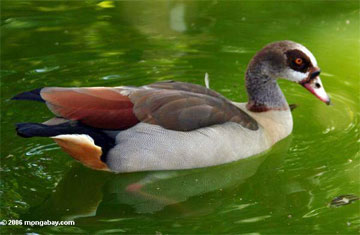Common wood duck and laughing gull could transmit bird flu in America
Common wood duck and laughing gull could transmit bird flu in America
mongabay.com
October 23, 2006
The common wood duck and laughing gull are very susceptible to H5N1 avian influenza viruses (“bird flu”) and have the potential to transmit them according to scientists at the University of Georgia.
Their research, published in the November issue of the journal Emerging Infectious Diseases, shows that different species birds respond differently to bird flu viruses.
David Stallknecht, associate professor in the department of population health at the University of Georgia’s College of Veterinary Medicine and co-author of the study, said that “knowing which species are likely to be affected by highly pathogenic H5N1 viruses is a vital component of efforts to quickly detect the disease should it arrive in North America,” according to a news release from the University of Georgia.
 The Egyptian Goose, Alopochen aegyptiacus, is not a bird flu threat in the United States .
|
“If you’re looking for highly pathogenic H5N1 in wild birds, it would really pay to investigate any wood duck deaths because they seem to be highly susceptible, as are laughing gulls,” said Stallknecht, a member of the University of Georgia’s Biomedical and Health Sciences Institute. “It was also very interesting that in some species that you normally think of as influenza reservoirs — the mallard, for instance — the duration and extent of viral shedding is relatively low. This may be good news since it suggests that highly pathogenic H5N1 may have a difficult time surviving in North American wild birds even if it did arrive here.”
The researchers said that monitoring wild birds for signs of flu outbreaks can be difficult due to differences between species, but that their research should help the effort.
“Doing avian influenza surveillance is pretty tricky because there are a lot of species differences and there are also seasonal differences,” he said. “So you’ve got to pick the right species at the right time and you’ve got to collect the right samples.”
Bird flu is typically transmitted in one of two ways say the researchers. With low-pathogenic avian influenza, the virus is spread through bird feces when other birds drink from contaminated water. With pathogenic H5N1 avian influenza, explains Stallknecht, the virus is usually spread through birds’ respiratory tract, make it highly virulent.
The University of Georgia research will continue under a new $2.6 million grant from the Centers for Disease Control and Prevention (CDC) to study the probability of transmission of bird flu from human contact with birds.







